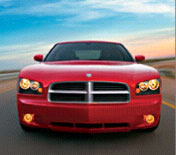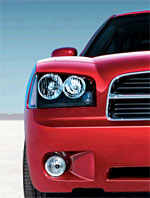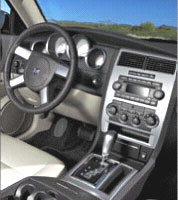2006 Dodge Charger Program #2440
The name Dodge Charger is synonymous with an era when Detroit iron and V8 muscle ruled the highways. In fact, it conjures up so many images of heady horsepower, that it is impossible to separate the real Chargers from the myths. Well, for 2006, the Dodge Charger is back. Not as a classic coupe, but as a full-size, rear-drive sedan. So, can this new version of the Charger make it to the finish line?
The 2006 Dodge Charger sets out to be a 21st Century interpretation of a classic Detroit muscle car. That is, one that’s aimed at a broad range of buyers that desire a big powerful car, from high performance enthusiasts, to families, and even the local constabulary. To get the word out far and wide, Dodge made sure Charger hit NASCAR ovals even before it arrived in showrooms.
 The showroom stock Charger lineup starts with the SE and SXT. Both are powered by the corporate 3.5-liter V6 engine with 250 horsepower and 250 pound-feet of torque. This will be the most popular Charger engine.
The showroom stock Charger lineup starts with the SE and SXT. Both are powered by the corporate 3.5-liter V6 engine with 250 horsepower and 250 pound-feet of torque. This will be the most popular Charger engine.
Next comes the R/T with the same 5.7-liter Hemi V8 used in the Chrysler 300C and Dodge Magnum R/T, with 340 horsepower and 390 pound-feet of torque. It includes Cylinder Deactivation that shuts down 4 of 8 chambers while cruising for an 8-10% economy gain. EPA ratings are 17 City and 25 Highway.
And then there’s the limited-edition Daytona R/T, its Hemi punching out 350 horsepower and 390 pound-feet of torque. And if all that wasn’t enough, a 425-horsepower SRT8 version with a 6.1-liter Hemi V8 will arrive next year.
All Chargers use a 5-speed automatic transmission with AutoStick manual shift mode. Most of the Charger’s mechanics are derived from the Dodge Magnum sports tourer and Chrysler 300. The 300 platform is such a watershed vehicle that it won MotorWeek’s 2005 Drivers’ Choice Award for Best Family Sedan.
But while based on the 300 and Magnum, Charger will not be available in all-wheel drive. It is rear wheel drive only, but with standard electronic traction and stability control.
The new Charger may be a 4-door sedan, but its near fastback roof line, high rear fenders, and squeezed side glass treatment hints at the coupe styling of the first Chargers. Compared to the 300 and Magnum, it’s a leaner, yet still mean look with a lower profile grille and wedgy headlights.
On the profile, short front overhang leads to big round wheel cutouts and substantial 17-inch rims on the SE and SXT, and 18-inchers on the R/T and Daytona. Wheelbase is the same as the 300, measuring 120-inches, but the Charger is a little over 3-inches longer overall. Around back is a short rear deck with properly understated fascia and lights.
 With a 4,031 pound curb weight for the R/T, this big car is also heavy, yet impressively light on its feet, as we found out on the curves of Virginia International Raceway where we got our first taste of today’s Charger.
With a 4,031 pound curb weight for the R/T, this big car is also heavy, yet impressively light on its feet, as we found out on the curves of Virginia International Raceway where we got our first taste of today’s Charger.
Unlike classic muscle cars that were only exhilarating in a straight line, this full-size sedan’s short-long arm front and rear multi-link suspension make it quite capable of managing the bends in the road as well. Add the Road/Track Performance package to the R/T, with its wider tires, self-leveling shocks and faster steering, and the Charger handles well with fine balance for its size.
Smooth corner entries and wide, fast lines yield the best lap times. Turn in too sharply, and the front end will push hard and spoil the fun. The stability control is well tuned not to intervene too quickly. But while the steering is quick, it definitely needs more feel.
The big Hemi V8 delivers plenty of grunt out of the corners and down the straight bits. The R/T’s standard 4-wheel disc brakes with ABS deliver plenty of stopping power, but like the steering, lack feel. On more sedate pavement the Charger R/T has a tighter ride than the 300C, but it still feels on the soft side. It is still that Hemi rumble, however, that reminds you that this is no ordinary family car.
 Inside, the boy racer kinship to the Dodge Magnum is obvious. The cabin is expectedly roomy, if a little claustrophobic, due to the short side glass. Seating is firm and well padded, with the R/T including a standard 8-way power driver’s seat. All the luxury and convenience features of the 300 and Magnum are available, including power adjustable pedals, high end audio with SIRIUS satellite radio, and DVD-based navigation system, plus automatic climate controls.
Inside, the boy racer kinship to the Dodge Magnum is obvious. The cabin is expectedly roomy, if a little claustrophobic, due to the short side glass. Seating is firm and well padded, with the R/T including a standard 8-way power driver’s seat. All the luxury and convenience features of the 300 and Magnum are available, including power adjustable pedals, high end audio with SIRIUS satellite radio, and DVD-based navigation system, plus automatic climate controls.
The rear seat is big and comfortable with a 60/40 split folding seat back. An optional DVD entertainment system keeps the kids quiet on long trips. Trunk space is also suitable for long hauls. At 16.2 cubic feet, it’s even larger than the trunk in the 300.
Prices, fortunately, are slightly smaller. The base SE goes for $22,995, with the SXT priced at $25,995. The R/T costs $29,995, and the limited-edition R/T Daytona $32,495.
The 2006 Dodge Charger is a long way from the stripped down muscle car of the mid-1960s. It’s a muscle car for today, with big power and performance, but all the amenities that 21st century drivers demand. The new Charger is as big and bold as the original, as it charges into a new era and across the finish line.
Specifications
- Se/sxt: 3.5-Liter V6 250 Horsepower 250 Lb./ft. Torque
- R/t: 5.7-Liter Hemi V8 340 Horsepower 390 Lb./ft. Torque
- Daytone R/t: 5.7-Liter Hemi V8 350 Horsepower 390 Lb./ft. Torque
- Srt8: 6.1-Liter Hemi V8 425 Horsepower






